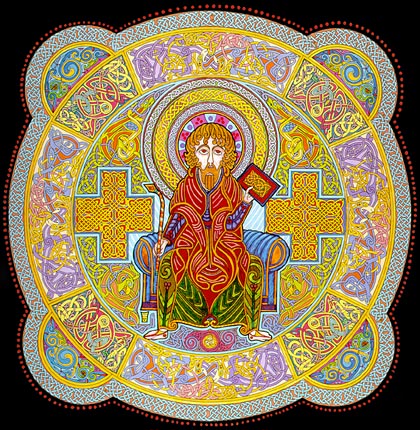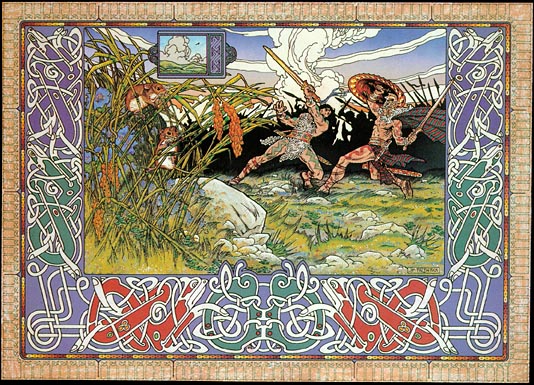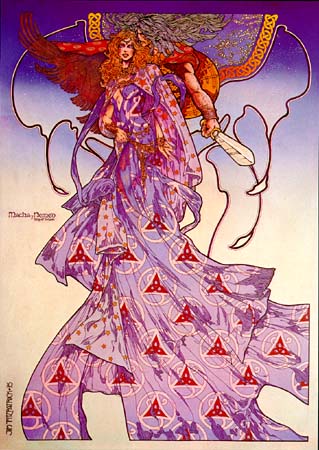Of Celts and Nameless Cults: The (Irish) Nemedian Chronicles
Wednesday, March 11, 2009
posted by Deuce Richardson
 Print This Post
Print This Post

“Know, oh prince, that between the years when the oceans drank Atlantis and the gleaming cities, and the years of the rise of the sons of Aryas, there was an Age undreamed of… (…) Hither came Conan the Cimmerian… “
– The Nemedian Chronicles
In December, 1932, the words above first introduced Conan the Cimmerian and his Hyborian Age to twentieth century America. Readers from every generation since have been intrigued by that heading from Chapter I of “The Phoenix on the Sword.” In a previous post, I discussed just what Robert E. Howard might have meant by “the sons of Aryas.” Why would a ‘Nemedian chronicler’ from Hyborian Age Nemedia speak of the Hyborian Age as “an Age undreamed of”?
For the sake of argument, let us suppose that this ‘chronicler’ was writing during the fin de siecle of the Nemedian nation, five hundred years after Conan the Cimmerian, when Æsir mercs-turned-nobles were holding a “Siegfried Line” against their own, unsoftened brethren. Certainly, the threat of the Cimmerians (ancestors of the Irish and Scottish Gaels, according to REH) was in the air as well. Would this ‘chronicler’ call his own age “undreamed of”? That seems hard to believe. Such a thing would be somewhat analogous to me telling my nieces today, “Know, oh nieces, that between the rise of Teddy and the freezing of the financial markets, there was an Age undreamed of… the American Age.” I concede that in these decadent times when everything is “so five minutes ago,” when traditions and memories of a few decades past are one with forgotten ages, that my analogy is not exact. Still, there is zero reason to believe that the ‘chronicler’, whoever he might have been, was living during the Age of which he was writing. The epigram makes no sense if he was.

Would the ‘chronicler’ (if he was an Hyborian Age Nemedian) look back on the career of Conan, a Cimmerian who dealt Nemedia a crushing blow half a millenium before, with nostalgia and immortalize it in a ‘chronicle’? Possible, in the sense that all things are possible. I’d say the motivation for such an act would be scant and thin on the ground. If nothing else, this hypothetical ‘Hyborian Age Nemedian Chronicler’ would best serve his tow-headed ‘prince’ by regaling the boy with tales of the early days of the Æsir take-over, when men were men. Men whose blood coursed through the veins of said ‘prince’, not some Cimmerian adventurer whose distant kin even now ravened at the borders. To do otherwise, to dwell wonderingly upon the unstoppable might of but a single Cimmerian warrior, would be akin to psychological warfare (a possibility I’m ruling out a priori). If not some ‘Hyborian Age Nemedian Chronicler’, then who did write those words which have echoed down the centuries to our own day (in a “sub-creational” sense)?
Robert E. Howard gives us some clues in the “Black Eons” fragment (The Horror Stories of Robert E. Howard, p. 505). In that fragment, he reveals that Friedrich Wilhelm von Junzt, the author of the “Unausprechlichen Kulten” (Nameless Cults, to Anglophones), had “discovered” the Hyborian Age. Von Junzt was a German born in 1795 who died in 1840. His ability to winkle out time-lost secrets and plumb ancient mysteries was uncanny, according to REH.
Patrice Louinet has asserted that Robert E. Howard wrote four drafts of The Hyborian Age. The Nemedians (both the ethnically Hyborian models and their AEsir/Irish namesakes) figure in each and every one. It is always best to keep in mind that when Robert E. Howard created the Nemedians, Conan the Cimmerian and the Hyborian Age, that he was in the midst of his “Celtic phase.” Evidence of Howard’s fascination with the Celts goes all the way back to a letter to Tevis Clyde Smith from January, 1926. His interest hadn’t flagged much by the time he wrote the initial epigram for “The Phoenix on the Sword.”
There is a connection between the Nemedians who were driven out by their Æsir brethren at the bloody close of the Hyborian Age and Von Junzt in nineteenth century Germany. It’s one that Robert E. Howard seems to have been aware of.
In his first letter to H.P. Lovecraft, REH wrote, “The Firbolgs and the Tuatha de Danaans, as you know, were represented to have been descendants of those Nemedians who escaped the swords of the Fomorians and returned to Greece, whence they had originally come to Ireland. Returning at various times, they were bitter rivals until the coming of the Milesians…” This passage was later echoed in his “The Hyborian Age” essay, where Howard explicitly linked the Nemedian AEsir of the Hyborian Age with “the Nemedians of Irish legendry.”

Could legends of the Hyborian Age have been carried to Ireland by descendants of the Nemedians? The Irish legends we have now, the same ones REH read and was inspired by, purport to trace the wanderings of various Celts from “Scythia” to Ireland, some events being placed as far back as 2438 B.C. From his readings, Howard was well aware that philologists tended to place the origins of the “Aryans”/Indo-Europeans in the general area of ancient Scythia (previously the domain of the historical Cimmerians), and, in fact, that is where he places his “Aryans” in the “Hyborian Age” essay.
In the letter to Smith from January, 1926, Robert E. Howard wrote, “I could tell you a lot about the rise and decline of Ireland and how it was once the center of religion and Christianity and rivaled Rome, but I won’t bore you.” While it took Thomas Cahill to really spread the word to the masses (fairly poorly, in my opinion), the facts concerning the Irish “Age of Saints and Scholars” were in books written for popular audiences long before REH was born. In his History of Ireland, W.C. Taylor, no friend of the Gael, grudgingly admitted to the achievements of Irish scholars and missionaries in the British Isles and on the Continent. Taylor’s volume was published in 1854. Seumas MacManus’ The Story of the Irish Race (1921) devotes nearly seventy pages to following the course of Irish scholarship and monastery-building in western Europe. From the time of Saint Patrick to the end of the Viking Age, Irish scholars carried manuscripts and codices, preserved or written in Ireland, to continental Europe to be housed in monasteries and at the courts of kings like Otto the Great. Otto the Great of Germany.
The birthplace of Friedrich Wilhelm von Junzt was never stated by Robert E. Howard. We do know that he was a German, and that the first edition of Nameless Cults was published in Dusseldorf. Not far south of Dusseldorf are several monasteries with strong, ancient ties to Ireland, the monasteries at Salzburg and Regensburg among them. Considering the talent for seeking out “hidden things” that REH ascribed to him, it is by no means impossible that in one of those monasteries von Junzt “discovered” the Hyborian Age.
*All illustrations by Jim Fitzpatrick.
